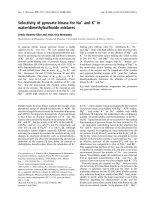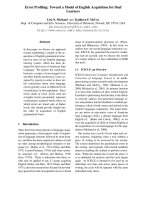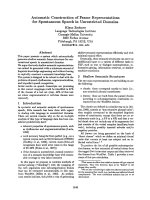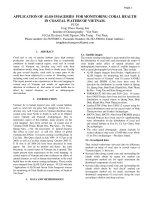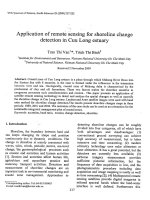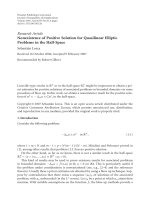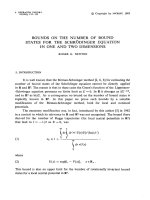MODEL OF TEACHING QUESTIONS FOR COMPREHENDING ARGUMENTATIVE TEXTS IN LITERATURE SYLLABUS AT HIGH SCHOOLS
Bạn đang xem bản rút gọn của tài liệu. Xem và tải ngay bản đầy đủ của tài liệu tại đây (919.11 KB, 27 trang )
MINISTRY OF EDUCATION AND TRAINING
VIETNAM INSTITUTE OF EDUCATIONAL SCIENCES
PHAM THI HUE
MODEL OF TEACHING QUESTIONS FOR
COMPREHENDING ARGUMENTATIVE
TEXTS IN LITERATURE SYLLABUS
AT HIGH SCHOOLS
Major : Teaching theory and methodology
subject of Literature – Vietnamese
Code : 62 14 01 11
DOCTORATE THESIS ABSTRACT
OF EDUCATIONAL SCIENCES
HANOI - 2014
The work was completed at:
Vietnam Institute of Educational Sciences
Scientific mentors:
1. Bui Manh Nhi, PhD, Associate Professor
2. Nguyen Thi Hong Van, PhD
Opponent 1: Nguyen Thanh Hung, PhD, Professor
Hanoi national university of Education
Opponent 2: Nguyen Thi Hanh, PhD, Associate Professor
Vietnam Institute of Educational Sciences
Opponent 3: Nguyen Thuy Hong, PhD, Associate Professor
Ministry of Education and Training
The thesis would be defended in front of Doctorate Thesis
Council at Vietnam Institute of Educational Science, 101 Tran
Hung Dao, Hanoi
At ….date….month….year…….
The thesis could be studied at:
- National Library;
- Vietnam Institute of Educational Science Library
RELATED PUBLISHED WORKS BY THE AUTHOR
1. Pham Thi Hue (2011), “Instructions for students to make
questions by themselves in teaching Literature”, Education
Journal, Vol 269, September, pp.33.
2. Pham Thi Hue (2012), “Model of teaching questions for
comprehending argumentative in Literature syllabus at
high schools”, Education Journal, Vol 85, October, pp.37.
3. Pham Thi Hue (2013), “ The process of building and
developing the model of teaching questions for
comprehending argumentative in Literature syllabus at
high schools”, Education Journal, Special Vol, April,
pp.92.
1
INTRODUCTION
1. Rationale of the topic
1.1. With a view to implement educational innovation in Resolution
No.29-NQ/TW on 4
th
November 2013 in the 8
th
National Congress Phase
11 that is about educational and training reform, it is urged to continue
greatly innovating learning and teaching methods with an emphasis on
students’ activeness in learning. Students are expected to be the subjects to
gain knowledge with the ability to apply the knowledge and skills being
taught into real life.
1.2. Questions are basic and vital tools in teaching. Raising questions
means identifying problems, stimulating thinking to look into and solve
the problems. Hence, questions are regarded as an active learning tool, a
goal that needs reaching in capability improvement program. To meet this
requirement, students not only need to make questions but also have to
choose the right approach to understand the core value.
1.3. How to build up questions during the teaching process plays a
very important role. Among the objectives of teaching Literature is
guiding students to receive and understand texts with their typical features.
That is why questions about core elements of each genre are necessary and
are must-haves in teaching reading comprehension. It is not an easy task to
realize key questions in teaching each genre, as well as to organize and
carry out activities with that question system in teaching. Even though
there have been a lot of discussion about this issue in course book for
pedagogical students or teaching manuals, in fact teachers are still
confused about designing and using questions system to teach reading.
1.4. As for argumentative texts, most of the time teachers and
students have difficulties in teaching and learning with the reading
comprehension tasks. Most of the argument texts in the course book have
not reached a high level of unity in questions model to instruct students to
understand the lesson. In the meantime, it is necessary that there be some
core and repeated questions in many documents to direct teachers as well
as students know how to find the beauty of this specific genre.
1.5.During our professional guide, we have come to a conclusion that
if teachers can master and organize the content of the lessons based on
logical and scientific questions system, and if students can raise questions,
debate and answer those questions given by teachers in learning activities,
the lesson then would be a true success. The problem is how to build up an
2
efficient questions model that goes on well with the content of the lesson,
especially in teaching reading comprehension of different genres.
With all the above-mentioned reasons, we have come up with the
research title of “Questions model in teaching argumentative texts reading
comprehension in secondary philology program”
2. Overview of the research
By reviewing questions being asked in argumentative texts reading
comprehension in some Western papers, it can be seen that questions play
an important role as students are helped to identify and memorize
information from the texts. Questions are also the tools to guide students in
the cognitive process since making questions is considered to be one of the
skills that helps form and develop reading comprehension skills. In
Vietnam, there have been materials that mention the concept, requirements
and principles to build and categorize reading questions, but they are not
comprehensive and systematic enough to design and utilize questions
effectively in reality. In terms of questions to teach argumentative texts,
foreign papers’ reviews show that the integration with the other 3
remaining skills focuses on reading questions. These questions stick to all
the features of this genre and the requirements are basically at application
level in real life situations. In Vietnam, there has been no in-depth research
on questions and the model of questions in teaching argumentative texts
reading comprehension.
3. Objectives of the research
The dissertation aims at building up a model of questions to teach
argumentative texts reading comprehension and applying that model to
teaching and learning processes so that teachers are orientated to design
questions to instruct students to read in an active and effective way.
Students then will step by step enhance their reading capability, which is
the objective of teaching Literature in secondary school, to learn through
their whole life.
4. Subject and object of the research
4.1. Research object
The teaching argumentative texts reading comprehension process in
secondary philology program
4.2. Research subject
The questions being used in teaching argumentative text reading
comprehension process
5. Research methodologies
5.1. Literature reviewing
3
5.2. Expertise
5.3. Interviewing, surveys and questionnaires
5.4. Pedagogical practicum
During the process of looking for supporting ideas and organizing
them to prove the scientific hypothesis, those above-mentioned methods
have been used flexibly in cooperation with other typical methods such as
Philological analyzing, historical methods, genres comparison methods, as
they have a strong and logical connection among themselves.
6. Mission and scope of the research
6.1. Mission of the research
- Doing a study on topic background including theories on teaching
reading comprehension, building up questions system and question models
to teach reading comprehension
- Looking into questions being asked in argumentative texts reading
comprehension task in textbooks of Vietnamese secondary philology
program; comparing these with those of other countries, so as to draw a
lesson to propose question models to teach argumentative text reading
comprehension in Literature.
- Proposing objectives and regulations to build up general and
specific models; employing them to use in teaching process; assessing
students’ reading comprehension and initially proposing to reform guiding
questions system for reading comprehension in textbooks.
- Experimenting the questions model in building up lesson plans and
reading class facilitation with some of the argumentative texts in secondary
philology program
6.2. Scope of the research
The dissertation does not dig deep into question structuring model
(forming structure of questions) but focus on question system models (a.k.a
question models) which are used in teaching argumentative text reading
comprehension. Teaching questions in reading comprehension is also called
reading comprehension questions.
7. Scientific hypothesis of the topic
Once the model is built up, teachers will have foundation and
direction to design the specific question system, as well as the ability to
organize and facilitate students’ learning activities so as to instruct them to
read the texts with their typical features. This is actually one of the
objectives of teaching Literature in secondary program.
8. Contribution of the paper
8.1. Theoretically
4
-Formulating concepts of reading comprehension questions, question
models in teaching reading comprehension.
- Identifying goals, features and principles to produce questions
model for teaching argumentative texts
- Proposing the questions model and directing to apply these
questions to teach reading comprehension as genre typical features
suggest.
8.2. Practically
- Proposing models to direct teachers to exploit core elements of
argumentative texts, then help students to understand the beauty of the
texts as well as know how to read this kind of document.
- Orientating teachers in producing and implementing questions
system in teaching specific reading comprehension texts in coursebook so
that they know how to design lessons out of the syllabus so as for students
to establish and develop reading and writing abilities.
- Contributing to building up questions bank to assess reading
comprehension and to design teaching materials such as students’ books
and teachers’ books, etc.
9. Organization of the research paper
Except for Introduction, Conclusion and Appendix, Reference, the
paper includes 3 chapters with the content mentioned as follow:
Chapter 1. Literature review on questions model to teach
argumentative texts reading comprehension in secondary philology
program
Chapter 2. Establishing and implementing questions model in
teaching argumentative texts reading comprehension in secondary
philology program
Chapter 3. Pedagogicexperiment
5
CHAPTER 1
LITERATURE REVEW ON QUESTION MODELS
TO TEACH ARGUMENTATIVE TEXTS READING
COMPREHENSIONIN PHILOLOGY PROGRAMS
AT SECONDARY SCHOOLS
1.1. Reading comprehension and the model of questions to teach
reading comprehension
1.1.1. Reading comprehension teaching
1.1.1.1. Review on text reading comprehension and teaching reading
comprehension
Reading comprehension is the whole process of direct exposing to
texts (including the sensing process of material signals and realizing the
meaning of those signals); is the cognitive and thinking process
(receiving and analysing the meaning of texts, reading between the lines,
decoding symbols and the hidden meaning, restating in readers’ words to
create the meaning of documents); is the feedback process to utilize texts
(changing readers’ cognition, ideas, emotion so as to find the historical
meaning and values of documents in different eras)
The objectives of reading comprehension teaching are not only to
help students understand the content and arts of the work but also to
helpthem read, understand, experience different feeling stages and
thoroughly think about the texts under the supervision of teachers. Hence,
students will have skills and methods to read in order to comprehend
which is one of the basic abilities of human in social life. The nature of
reading comprehension teaching is facilitating students with steps and
skills to master the piece as an active reader with a particular goal of
using the documents.
The teaching process can be divided into 3 main stages: pre-reading,
while-reading and post-reading. In each stage, several ways of reading
should be used such as speed reading, silent reading, skimming, voice
reading, expressing reading, etc. Some methods should also be employed
including decoding, gap filling, particularizing, etc. Similarly, some
cognitive techiques such as problems identifying, analyzing, explaining,
evaluating and commenting, etc. are also used. Generally speaking, all of
these methods and techniques are used in good and flexible cooperation
during the whole process of teaching reading comprehension
1.1.1.2. Teaching reading based on typical features of genres
6
Reading any documents needs to use a specific way of reading.
Teaching literature in the spirit of reading comprehension is merely
teaching students this reading method. As each document has its core and
basic factor that creates typical features for that genre, reading
comprehension teaching is to provide students with methods to look into
the meaning of texts based on those core and basic elements. If students
can master this method, they will know how to read and understand
different kinds of texts with ease. The theories on different genres that the
textbook provides among texts are the tools that support the reading
comprehension process. However, the knowledge about genres is just
orientating as these genre features are of pretty fixed patterns whereas each
text is a distinct creation of writers which exists in a specific and definite
form of one genre or in the cross-genres. Those genre features are
expressed vividly and clung to the specific and distinct content of each
piece. Therefore, it is advisable that the text decoding process,
understanding and creating text meaning need to combine genres
background knowledge with specific reading skills in order to avoid being
imposed and dogmatic in reading comprehension.
1.1.1.3. Reading comprehension teaching with students-centered
activities
In order to make students’ reading comprehension activities more
constructive, first teachers need to inspire students to take interest in
reading the texts and once they have motivation and goals set, they will
enthusiastically be involved in text receiving process. Teaching reading
comprehension also needs to be student-centered with experience
activities, basic activities, practice activities, application activities,
expanding activities to create opportunity and urge students to look into
and expose to the texts in an active and confident way. Instead of reading
and analyzing the texts for students, or talking too much, teachers should
put a lot of questions as well as guide them to make questions, encourage
them to state their own opinions when reading. Using questioning
techniques in teaching reading comprehension should be viewed from
different perspectives in a multi-dimension relation which closely supports
other active teaching methods so that readers – students can enhance their
activeness and creativeness in reading comprehension teaching.
1.1.2. Models in texts reading comprehension teaching
1.1.2.1. Questions in teaching and in teaching reading texts
a) Questions in teaching
7
Questions are the center of dialogue technique. In order for dialogue
method to enhance students’ activeness and to be highly educationally
effective, teachers need to build up a suitable question system and closely
cooperate with other methods in the working periods following the logic of
that system. All the questions must be students-centered, and they cannot
be just guiding questions that act as linking steps or leading to teachers’
imposing conclusions about the lesson content.
In modern teaching, the subjects of questions are not only teachers,
but also students. The fact that students raise questions is an organic
element of learning activity, representing activeness in interactive reaction
to teachers and learning content. Questioning helps practice thinking and
language abilities, communication skills, behaviors and confident attitude
in learning. Encouraging students to make questions and teaching them to
do it are methods to do active teaching.
b) Questions in teaching texts reading comprehension
Reading comprehension questions are questions used to guide,
facilitate reading activities for students, in order to help them with reading
methods so that they can read themselves. In reading comprehension
teaching, teachers raise questions to activate, direct, elicit, instruct students
to take part in decoding, creating text meaning so students know how to
thoroughly understand text meaning. On the other hand, students also need
to make questions during the direct text exposing process as an
independent reader to share his/her own experience, understanding with
other readers (including teachers and peers).
When and after answering questions, students not only understand
the value of the texts but also know how to find texts meaning, or read
texts of the same genre. Students then become the subjects that directly
expose to the texts, being active readers with reading methods (not passive
readers, following teachers without any specific goals)
Questions in reading comprehension teaching are of great variety
both in content and form, however, the question system of a lesson on the
one hand needs to rely on the content and text type; on the other hand,
needs to ensure different levels of reading comprehension process, which
can be seen in the following aspects:
Identifying questions are those that focus on collecting and managing
information out of and identifying key information in the texts
Analyzing and explaining questions include those heading for
pointing out, clarifying content and the relation among different parts or
paragraphs in the text, or that between the title and the whole text;
8
explaining the organization, word choice and expressing methods to
present ideas and content of the text; clarifying meaning and content as
well as arts value of the text.
Evaluating and feedback questions go for tackling comments,
judgments based on thorough understanding of the text; presenting multi-
facet effects of the text to readers. These questions require students to have
precise deduction and evaluation about the text so as to apply the texts
flexibly and creatively.
1.1.2.2. Questions model in teaching reading comprehension
The questions model in teaching reading comprehension is a short
form of expressing main features of core questions system being used the
text reading comprehension process. The characteristic of the questions
model is visuality (with models, teachers and students can realize the basic
way to master; approach the texts with their genre features as well as
different levels and aspects of this process; understand different kinds,
forms and categories of questions being used in the process); stability (the
model covers core questions that any documents of the same genres have
to be questioned to reach the objectives and create the reading skills being
needed to read other texts of the same genre); “openness” in application
(based on the model, people can build up a system of various open
questions)
Core questions are those with the content going along with basic
concepts, skills and methods that learners have to master. Open questions
are those with the details of core questions, or those with content being not
directly involved in core questions but can be used as an elicitation device
to elicit, direct or instruct the way to find the answer to the core questions.
A reading text can have more than one core question, and is of rather
limited number (normally less than open questions). One core question can
have many open questions but it is not necessary that any core ones have
to have open ones.
1.2. Teaching argumentative text reading comprehension in
literature coursebook of secondary program in Vietnam
1.2.1. Argumentative texts
1.2.1.1. Definition and features
In terms of text genre, argument is the kind of text in which writers
use reasons to persuade people to follow their ideas and viewpoints so that
they will share the same attitude and actions in life. In terms of expressing
method, this kind of text mainly employ reasoning with evidence. The
documents of this genre being employed to be the subject of reading
9
comprehension activities in philology program in secondary schools are
called argumentative text. In this paper, the term argumentative texts has
been used to maintain the unity with the concepts in the coursebook.
The main feature of arguments is the persuasion, compelling logic,
and generalization. To talk about arguments, people have to mention topic,
discussion point, evidence and argument. Topic is the main issue that
needs to be dealt with and discussed. That topic is developed into many
discussion points. Discussion point is the idea, viewpoint or opinion of the
speaker or writer about the issue. Evidence is the truth, reasons, examples
to be the foundation for the opinions. Argument is the organization of
ideas, the cooperation among evidence to prove the standing point.
In terms of ideology, argumentative texts are actually those used to
persuade with direct reasons for arguments so the ideology can be seen very
clearly. It is the outcome of logical thoughts, vigilant and sharp thinking in
order to present writers’ ideas and viewpoints in a clear way.
In terms of language, the wording in argumentative texts is not arid
or lack of expressiveness because of reasoning with evidence, or being the
outcome of logic thinking. Emotiveness is also an important factor that
creates the typical persuasive feature of arguments. It is created by the
strength of proofs and reasons, the writers’ enthusiasm in persuading
people that can be seen in their tone. Preciseness is a basic feature of the
language in argumentative texts, too.
1.2.1.2. The roles of argumentative texts in life and in the secondary
philology program
In our real life, arguments are inevitable and somehowparts of your
success can be determined by your reasoning and persuading skills about
one idea, or viewpoints on some issues.
In our current Literature program, arguments play a remarkable role.
Being the subject of text-reading sub-category in literature, argumentative
texts account for 8% to 21% in the total number of texts in reading
comprehension section. Arguments have been taught since Grade 7 to
Grade 12 and there are no senior secondary school entrance and final exams
or university entrance exams without writing arguments skills.
The current philology program in secondary schools includes
different kinds of reading texts. Vietnamese arguments in the old time are
popular with royal proclamation, royal edict-like announcement,
proclamation, tale addressing, title, literature piece on stele, letters, etc.
The modern ones in Vietnam and foreign countries cover 2 main types:
literature arguments and social arguments
10
1.2.1.3. Teaching objectives of argumentative text reading
comprehension teaching
These objectives should be built up in the direction of improving
students’ reading comprehension capability and forming modern human
beings’ characteristics to meet the requirements of integration in the
current society. In particular,
- Students understand the value of content and arts of the specific
argumentative texts and then create and develop critical reading skills.
- Students are aware of the variety and comprehensiveness of the
documents and literature in general.
- Students broaden their knowledge about literature, improve their
understanding about real life and can apply when they do social works.
- Students know how to evaluate problems in real life, with critical
thinking skills to form their own viewpoints or outlook on life
- Students know how to read different kinds of texts critically, and
then have reading abilities, one of the vital skills for their future.
1.2.2.The situation of establishing questions system in teaching
argumentative texts reading comprehension
1.2.2.1. Questions system in coursebook
a) Advantages
First, questions represent the spirit of teaching reading with genre
typical features
Second, students’ active participation in reading activities are
emphasized
Third, the question systems can be used to categorize students’ level
b) Disadvantages
First, the questions system has not fully focused on different levels
and aspects of reading comprehension
Second, this system is not likely to enhance active thinking and
requires students to deduce at a high level in the reading process
Third, not much integration with other skills can be seen in this
questions system.
1.2.2.2. Comparing and contrasting questions system in teachers’
manual and teaching hours with that in course book
After looking into teachers’ manuals and observing classes, we came
up with specific results which help us have some initial opinions as follow:
a)Questions system in teachers’ manuals
Advantages: Teachersare aware of the role of questions in students’
activeness in learning. Questions are stuck to text typical features, especially
11
arguments. Besides, questions can be used to categorize and integrate well
with other skills.
Things to improve:There is a lack of unity and logic in these
questions. Some are too easy while others are too difficult. The wording is
rather monotonous and repetitive. The instructions are not really directing
students’ learning activities or giving any clue to find a good method to
read and find the answer. The questions are mainly explaining and
lecturing, not for reading comprehension. There seems to have no
elicitation, situation raising, reality association to form living attitude for
students.
b) Questions system in teaching hours
Advantages:Teachers are aware to use instructing questions to guide
students’ reading comprehension activities. They have also combined
dialogue technique with other activities. Moreover, they have paid
attention to change the way questions are raised with greater variety.
Teachers now take notice of students’ feedback and encourage them to
make questions.
Things to improve:The questions are still one-way of asking and
answering with a lack of direction and instructions to do specific reading
activities. The way they organize forums and debates showing students’
opinions in front of the whole class is not effective and appealing to
students.
c) Contrasting questions in teachers’ manuals and teaching
hours with guiding questions in course book
Teachers have to base on the objectives of lessons and students’
cognitive and skill levels to modify the questions in coursebook to make
their own questions system. Teachers then need to be instructed to design
questions system scientifically and effectively based on questions in the
coursebook. Hence, it is vital and urgent to build up a questions model to
teach reading comprehension.
12
CHAPTER 2
ESTABLISHING AND IMPLEMENTING
QUESTIONS MODEL IN TEACHING
ARGUMENTATIVE TEXT READING COMPREHENSION
IN PHILOLOGY PROGRAMSAT SECONDARY SCHOOLS
2.1. Identifying objectives of building up questions model in
teaching argumentative text reading comprehension
2.1.1. General view
Building up questions model in teaching argumentative text reading
comprehension aims at continuing to innovate literature teaching and
learning methods and to assess with a view to forming abilities and skills
to apply knowledge learnt to tackle life problems.
2.1.2. Objectives
- Forming core questions framework generalizing content and
reading methods with genre features.
- Proving pre-eminence and effects of dialogue teaching techniques
in teaching reading comprehension.
- Utilizing question models to teach argumentative texts reading
comprehension to contribute to reform students’ reading and writing
assessment to meet the objectives of the subject in secondary educational
program after 2015.
2.2. Identifying principles to build up questions model in
teaching argumentative text reading comprehension
In addition to making sure that all requirements are met, this model
needs to follow typical principles stated below:
- Requirements aboutforming and enhancing students’ reading
comprehension abilities
- Requirements aboutteaching reading comprehension following
genre features
- Requirements about active teaching
- Requirements aboutintegrated teaching
2.3. Proposing models of question in teaching argumentative text
reading comprehension
2.3.1. Question model in argumentative text reading
comprehension
During the teaching process, teachers need to design a system of
questions to facilitate students to receive argumentative texts at their core,
following the genres features. This should be carried out every
13
timeargumentative texts are taught, along with guidelines about reading
skills so that students can understand the beauty of each piece of work and
know how to read an argumentative text comprehensively. The model of
questions in teaching argumentative text reading comprehension can be
seen in the following diagram:
14
TOPIC
DISCUS
SION
POINT
EVIDEN
CE
ARGUM
ENT
ARGUM
ENT
FORMA
T
THOUG
HTS
AND
FEELIN
GS
FEATUR
ES OF
ARGUM
ENTATIV
E TEXT
PROCES
S OF
ORGANI
SING
TEACHI
NG
READIN
G
COMPR
EHENSI
ON
Questi
ons
about
the
solidity
and
reliabil
ity of
eviden
ce
Questio
ns
about
the
suitabl
eness
betwee
n
discussi
on
point
and
evidenc
e
Quest
ions
about
exami
ning
thoug
hts
and
feelin
gs of
autho
r
Ques
tions
abou
t the
effec
ts of
the
text
Ques
tions
abou
t the
logic
of
discu
ssion
point
and
evide
nce
Quest
ions
about
the
distin
ctiven
ess of
argu
ment
Que
stion
s
abo
ut
the
tone
s of
art
fact
ors
CORE QUESTION SYSTEM
OPEN QUESTION SYSTEM
Questio
ns
about
examini
ng the
persuasi
veness
and
logic of
the
argume
ntative
system
Questio
ns
about
perceiv
ing
general
meanin
g
(conne
cting
topic
senten
ces)
Questi
ons
about
examin
ing
newsre
el
meani
ng
(comp
ared
with
era
meani
ng)
Ques
tions
abou
t
detec
ting
subje
ct
(topic
word
s/sen
tence
s)
Quest
ions
about
the
suita
blene
ss
betw
een
forma
t and
conte
nt
COMPREHENDING
ARGUMENTATIVE TEXT
15
- Questions about Topic: What does the text discuss? Is the topic
new, special and meaningful? (in the text forming as well as current
contexts?) Students are required to comprehend the meaning of the title,
detect repeated words and phrases in the text; find out topic sentences;
know how to compare and contrast matters raised in the text and other
texts by the same author and in the same age in order to catch the unique,
advanced and exceptional differences; know how to connect to the
problem of text to the context to understand the topic; know how to
present the effects of text on their own thoughts and feelings.
- Questions about Discussion point: How diversifiedly and
persuasively does the text develop discussion points? Students are required
to perceive opening or closing sentences and understand their meanings,
generalize their meanings to find out discussion points; know how to point
out the meaning connection between discussion points and between them
with the topic; know how to regconize, analyze, and explain the ideas
development; know how to draw lessons about giving ideas, consider a
matter about life and literature.
- Questions about Evidence: Is the evidence precise, sharp, and
fresh? Which level of representativeness, generalisation, diversification,
richness, and clarity are the data and evidences in? Students are required to
differentiate argument and evidence; analyze and explain the suitableness
of evidences for discussion points; give some hypothesis of developing
evidences; apply to synthetise knowledge about reading comprehension,
literature understanding, life experience so as to clarify the author’s points
or find other ways to develop discussion points; examine correctly the
evidence system that the text set up.
- Questions about Argument: How persuasively and logically
does the text argue? Students are required to read through the text again,
regconise the argument chain, the logic of the matter; know how to use
mind map, tables and charts, mind map to explain the arrangement of
ideas; know how to analyze the persuasiveness and explain the chosen
arguments; intergrate Literature knowledge to understand thoroughly and
analyse, explain appropriately the art of arguments of the questions;
underline connective words and phrases placed at the beginning of the
sentences and paragraphs, and explain their meanings, apply the effective
arguments of the text to speaking and writing skills for specifically
communicative purpose.
16
- Questions about Argument format: What is the meaning of
vocabulary range applied in the text in expressing the topic of the text and
the author’s thoughts and feelings? How are the tones and emotions of the
text expressed and how meaningful are they in persuading listeners and
readers? Students are required to find out the special format signals of the
vocabulary range, sentence structures, paragraphing, opening and closing
arrangement, and their precise and deep meanings in clarifying the topic,
discussion points, and evidences.
- Questions about Thoughts and feelings: What is the author’s
attitude in the text (for or against, praise or criticise, positive or
negactive)? What is the author’s feeling in the text (respect or adore, etc.)?
What are the author’s thoughts? Students are required to read the text
several times to recognize the author’s thoughts and feelings through the
tones, sentence structures, vocabulary usage, subject’s or object’s
addressing. Furthermore, based on discussion purposes and aimed objects
of the text, students have to judge the author’s thoughts and feelings.
2.3.2. The model of teaching questions for comprehending
medieval argumentative text
The model of teaching questions for comprehending medieval
argumentative text is basically similar to the model of teaching questions
for comprehending general ones. However, because of the “merged
literature, history, and philosophy” characteristic, the convention of
medieval argumentative text, the model of this kind of text has its own
features. Based on the general model and other aforementioned focused
points, the core question system about comprehending medieval
argumentative text could be:
Question 1: What is the ideological/political topic raised in the text?
What is its meaning at that and current times?
Questions 2: Compared with the convention of types, how innovative
is the development of discussion points, evidences, and arguments?
Question 3: The convincing art of the text(abiding and obeying strict
regulations about types, tones, language, etc.)
Question 4: Judging the argumentative subjects.
Questions 5: Judging historical lessons, ideological lessons to the
students themselves.
2.3.3. The model of teaching questions for comprehending modern
argumentative text (literature argument)
Because modern argumentative literature discuss matters which are
plentiful and diversified in contents, bearing the stamps of authors,
17
illustrating unique and fresh approach, the model of teaching questions of
this kind of text expresses the requirements of the of teaching questions for
comprehending general argumentative text and its own ones. The core
question system about comprehending modern argumentative text could
be:
Question 1: What is the topic discussed in the text?
Question 2: What is new in the way the author approaches and
examines matters?
Question 3: How convincing is the system of discussion points,
evidences, and arguments?
Question 4: Is there any special about language, tones, etc.?
Question 5: Could any lesson be drawn from judging and discussing
a literature matter by reading the text?
2.3.4. The model of teaching questions for comprehending modern
argumentative text (social argument)
Modern argumentative text discussing social matters should be
employed from the angles of education, newsreel meaning, the author’s
unique views and innovativeness in solving problems. Therefore, the core
question system about comprehending modern argumentative text could
be:
Question 1: What is the topic of the text? What is the newsreel and
historical meanings of the matters?
Question 2: What is new and unique about the author’s views in
detecting problems and suggesting solutions?
Question 3: What is the author’s convincing art (tones,
communication, language, discussion, etc.)?
Question 4: What is the message the author wants to send to readers?
Is that meaningful to the students?
Questions 5: Are there other ways to convince about the problems
raised in the text?
2.4. The process ofbuilding the question modelof teachingreading
comprehension of argumentative text
The process consists of5 followingsteps:
Step1:Thoroughly graspingthe characteristicsofargumentative text.
Step2: Researching on the process of teaching text reading
comprehension.
Step3:Studying the specificobjectives of the lessons.
Step4: Selecting teaching methodsand organizational formsof
teaching.
18
Step5: Building thekeyquestions.
2.5. Applying the question modelin teachingargumentative text
reading
2.5.1. Applying thequestionmodelin organizingthe process
ofteachingargumentative text reading
2.5.1.1. Applying thequestionmodelinorganizing class time teaching
Step1: Preparation
a)Teachersidentifylearning needsofstudents.
b) Study lessons.
Step2:Implement the questionmodelin teachingreading
comprehensionwith aspecific question system.
a)Orientquestions’ content:
b) Select anddetermine the necessary extentto be reached for the
questioncontentcorrespondingto the requirementsof knowledgeand reading
comprehension activityofstudents.
c) Classifyquestions relevantto the ability ofeachstudent group.
d) Select and coordinatemethodsandforms ofteachingorganizationto
usethe questions.
e) Arrangequestionsaccording tothe process oflessonactivities.
Step3: Evaluate and improvethe text model.
a)Receivefeedback.
b) Analyze, completequestions.
2.5.1.2. Applying thequestionmodelin guidingstudents toself-study
a)Instruct students to self-studybeforereadingnewtexts.
Processing steps as follows:
Step1: Teachersstudy the texts,objectivesto be achieved,
teachingcontentandcompile the question system according tothe model
mentioned above.
Step2: Teacherexamine and classify studentsinto groupsbased
onreadingabilityandattitudes toward learning. It should begroups of5-
7students, there are three ways to divide.
Step3:Teachers dividequestionsforthegroups, suggest
solutionandevaluation criteriaorgive mark forcompetition. Studying
vouchercan be usedforeachgroup.
Step4:Evaluateresults of lesson preparation.
b) Instruct studentsto ask questionsduringreadingargumentative
texts.
The question modelof teachingreading comprehensionwill
guidestudents toaskkeyquestions, knowhow to ask correctly, hit necessary
19
problems, avoidasking diffused questions, lack offocus and main points in
order toformaself-learningcompetence inreadingtextatspecific time:
whencheckingoldlessons, examining theself-studyat home, teachingnew
lessons, strengthening andtraining at the end of classes, or when
guiding students toself-studyat home.
2.5.2Applying the question model in evaluating students’ ability
inreading textcomprehension
Fromthe questionmodel of teachingreading argumentative
textsproposed, it is able to implementintospecific questionsto builda
library, a question bank to test andassessreading
comprehensionabilityofstudents for argumentative texts. Deployment of
the modelshouldpay attention tothe general constructing principles ofthe
questionmodeldescribedin Chapter2.The way to use specific question
system must be basedon the purpose andaims of testing andassessment.
a)Questions todetectthesis, theoretical pointsof the texts.
b) Questions toanalyze,explain thethesis, theoretical
pointsandfoundationsystem, the reasoning, the tone, the language of the
texts.
c) Questions toevaluate,reflect onlessons,cognition and impacts of
the texts.
2.5.3. Applying thequestionmodelincompiling question system of
reading text guiding in the textbooks
The questionsystem can be proposedinPhilologytextbookin the
coming periodas follows:
a) The question system ofreadingtextguided in thetextbook need
tobeconsistentforeachtype oftext.
b) The questionsshould bedividedaccording tothestages
ofreading(before, duringand whilereading), according to theusing
objectives(to reinforce basic knowledgeofthetext and reading,
toexpandknowledgereading,orgeneralizeknowledgeaboutcategory group,
orread selected texts).
c) Some forms of studying voucher or question voucher should be
used forteachers totest,assess the processofstudents’ self-readingat
home(before andafterclass hours).
d) Limitingquestions whichgive astatement, an idea, content with
available requests for students to explain or prove.
e) Increasing questions for text assessment and feedback.
20
f) It is necessary to integrate objectives to form and develop four
skills: reading, listening, speaking, and writingin thequestionsystem
ofreading comprehension guiding.
g) Reinforce to raise situation questions related topractical issues.
h) Renewing the presentation ofreading comprehension guiding
questions.
i) Teachersshouldfocus onguiding educators
toorganizeteachingreading for eachkind of texts,to helpstudentsunderstand
theinformation inthe textbook.
CHAPTER3
PEDAGOGICAL EXPERIMENT
3.1. General Introduction
3.1.1. Purpose and task of the experiment
3.1.1.1. Purpose of the experiment
The purpose of the experiment isto verifythe
validityofscientifictheoriesdescribedin this thesis.
3.1.1.2. Task of the experiment
The task is to chooseexperimentalsubjects; to organize lessons in
which using question models developed by teachers; to conduct an
inspection, evaluation of the experiment’s results.
3.1.2. Subjects andlocality of the experiment
3.1.2.1. Criteria to choose locality of the experiment
+ Ensure the facilityconditionsfor normal teaching and learning.
+ Hold qualified schoolmanagement, staffs andteachers who have
professional skills, enthusiasm, and a sense of responsibility.
3.1.2.2. Selection andtraining ofteachers forthe experimental period
+Teachers atyoungagewith3years or more of service, expertise at
qualifiedor morepassable.
+ Teachers hold enthusiasmin teaching, innovativeness in teaching
methods, and creativity in teachingPhilologyreading.
+ Teachershavecomputerskills, know how to useand also quite
frequently usethe Internetandanumber of teaching software
programsapplied in compiling and lecturing.
3.1.2.3. Selection theexperimentalstudents
Experimentalstudents atgrade7, grade 10, 11 and12.
3.1.3. Empiricalcontent
3.1.3.1. Building up lesson plans
21
We choosefourtextsto build up experimental lesson plans including:
Literary Significance(Hoai Thanh) grade7; The Virtuous and Talented is
The Life-sustaining Element of the Nation(Than Nhan Trung) grade10;
AnEraofPoetry(Hoai Thanh) grade11; The Roadto Become
aModernScholar(Nguyen Khac Vien) grade 12-Advanced.
3.1.3.2. TeachingOrganization
Experimentalperiod: SemesterII, school year 2011-2012, 2012-2013.
Experimentalteachingprocessconsists of8steps:
Step1:Determining theexperimentalsubjects.
Step2: Working with the experimental teachers.
Step3: Classroom observing,exchanging and
collectingopinionsofteachersandstudents about theteaching periods in two
experimental classes and control classes.
Step4: Organizing tests fortwoexperimental classes and control
classesafter theexperiment.
Step5:Reckoning up,analyzing, and processing
testresultsaftertheexperimentby the verification IndependentT-test.
Step6:Commentingand concluding the pedagogical experiment.
Step7:Adjusting the question system in teachers’ empiricallesson
plans.
Step8: Giving assessment and conclusion on the
feasibilityofapplying, developing the questionmodelof teachingreading
comprehension of argumentative texts.
3.1.3.3. Evaluation
a)On thequalitative side
We conduct a consultation withteachers andstudentsto
evaluatetheclassatmosphere, thestudents'reading comprehension
activitiesinexperimentalteaching hours; the attitude andinterest in
commenting ofstudentsonthe question systemin argumentative texts’
reading period.
b) On the quantitative side
We evaluatethe effectiveness ofteachingreading argumentative texts
following the question modelproposed in thethesisby the results of
students’reading argumentative text tests, according tothe following
levels:Excellent, good, passable, failed.
3.1.4. ExperimentalMethods
3.1.4.1. Comparative experiment
In order tofinddifferences of effectiveness
inteachingreadingargumentative textsbased on the question modelproposed
22
in the thesis, we carry outexperimentsontwodifferent subjectswho are
randomly selected, including thecontrolclassandthe experimental class.
3.1.4.2. Test experiment
To testthe hypothesis, we consider thedifference inreading
comprehensionabilityof argumentative texts ofthe control groupandthe
experimental groupby thetestresultsafterthe impact.
3.2. ExperimentalOrganization
3.2.1. Teaching experiment
3.2.1.1. Deployment ofteaching argumentative text reading
inexperimental classes
3.2.1.2. Classroom observation of teachingargumentative text
reading periodincontrolclasses
3.2.2. Evaluating experiment
3.2.2.1. Design test subjects and conduct tests
Designtest subjectsafterimpactfortworandom groups: experimental
classes andcontrolclasses. Eachexperimental classandcontrolclassdoestwo
tests: areading comprehension of argumentative texttest for the experiment
composed by teachersanda reading comprehension of argumentative text
outside the program, textbook is compiledby us.
3.2.2.2. Make statistics and process results
a) Make statistics and process test results after the experiment.
Oncehavingthe testresults, we use the verification Independent T-
test.
b) General conclusion
Indexhas shown thatstudents who learn the question model ofreading
comprehensionsuggested in the thesishavebetterresults.
3.2.2.3. Synthesizeand evaluateresults ofthe opinion
pollofteachersand students
a)The first method
Observe and assess classroomthe atmosphereof the controlclass and
the experimental class whenteachingreading comprehensionwiththe same
argumentative text.
b) The second method
Collect opinion of teachers(the one who observes classes and the one
who teaches experimental period) aboutthe designandimplementation of
the question system in theempiricallessons.
c) The third method
Use aquestionnaire to measureattitudes, interest, and
evaluationofstudentsparticipated inexperimentalperiodsabout the
23
systemquestionused inteaching argumentative text reading based on the
modelproposed in the thesis.
3.3. Reviewand Evaluation
3.3.1. Evaluation onapplication of the question model
inteachingreading comprehension of argumentative texts proposed
From the question modelproposed in the thesis,
teachershavepreparedthelessondesigns which use thequestion system as
the backbone of the lecture to guidestudents to read the texts. This
question systemensures aspects as well as specific steps of the process
oftext reading comprehension, consistency in following
thecharacteristicsof the argumentative text closely, integratingreading
andspeaking, writing,and simultaneously guidestudentsknowhow to read.
Following the experimentallesson plans, students haveinitiative, are
morepositive inself-learning; besides, studentsnotonlyknow theanswersfor
questions inthe textbook, but alsoknow to make questions.
Withthe question modelproposed, teachersinitiallyknow how
todesignlessonsandorganize class timein ways that buildcapacity, take
students’ studying activities to belearning-centered, whichis thebasic
activities, practical activities, applied activities; lesson plans have
combined the method of raising questions withother methods ofactivity
organization flexiblyand efficiently.
3.3.2. Conditions ofimplementingteachingargumentative text
reading based onthe question model proposed in the thesis
Teachersandstudentsneed to investa lotof preparationtime.
Teachersshould instructstudentshow tosearch andprocess
informationrelatedto the contentsof the lessonspecifically, detailed, and
closely. Studentshave tobe serious in self-learning and researchingbefore
the class.
Time durationperlessonshould beincreased so that teacherscan teach
carefully each typical documentforthe genrein order to
helpstudentsformcomprehension skillsfor that kind of texts.
The examination and assessment of learning outcomes are required
to be capability-oriented innovation.
Textbookis forguiding studentsto self-study scientifically, objective-
closed and easy to use, especially focused on the question
systemguidingreadingcomprehension.

